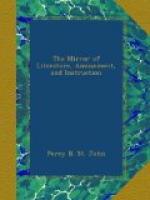The coypou or quoiya is a native of South America, very common in the provinces of Chili, Buenos Ayres, and Tucuman, but more rare in Paraguay. In size it is less than the beaver, which it resembles in many points. The head is large and depressed, the ears small and rounded, the neck stout and short, the muzzle sharper than that of the beaver, and the whiskers very long and stiff. There are, as in the beaver, two incisor teeth, and eight molar, above and below—twenty teeth in all. The limbs are short. The fore feet have each five fingers not webbed, the thumb being very small: the hind feet have the same number of toes; the great toe and three next toes being joined by a web which extends to their ends, and the little toe being free, but edged with a membrane on its inner side. The nails are compressed, long, crooked, and sharp. The tail, unlike that of the beaver, is long, round, and hairy; but the hairs are not numerous, and permit the scaly texture of the skin in this part to be seen. The back is of a brownish red, which becomes redder on the flanks: the belly is of a dirty red. The edges of the lips and extremity of the muzzle are white.
Like the beaver, the coypou is furnished with two kinds of fur; viz. the long ruddy hair which gives the tone of colour, and the brownish ash-coloured fur at its base, which, like the down of the beaver, is of such importance in hat-making, and the cause of the animal’s commercial value.
The habits of the coypou are much like those of most of the other aquatic rodent animals. Its principal food, in a state of nature, is vegetable. It affects the neighbourhood of water, swims perfectly well, and burrows in the ground. The female brings forth from five to seven; and the young always accompany her.
The coypou is easily domesticated, and its manners in captivity are very mild.
* * * * *
NOTES OF A READER.
* * * * *
RECORDS IN THE TOWER OF LONDON.
(From the Edinburgh Review, just published.)
[These stores are of invaluable interest, particularly with reference to the earlier and most obscure portions of our history.]
An immense collection of royal letters and state papers, miscellaneous rolls relating to the revenue, expenditure, debts and accounts of the Crown, New Year’s gifts, the royal household, mint, foreign bills of exchange, military and naval affairs, instruments relating to treaties, truces, and infractions of peace, chiefly between England and France; mercantile matters, foreign possessions of the Crown, proceedings in the Admiralty, military and other courts of the great officers of the Crown, pardons, protections, petitions, subsidy rolls, Scotch homage rolls, pardon rolls, privy seals, signet bills, writs of various descriptions from Edward




